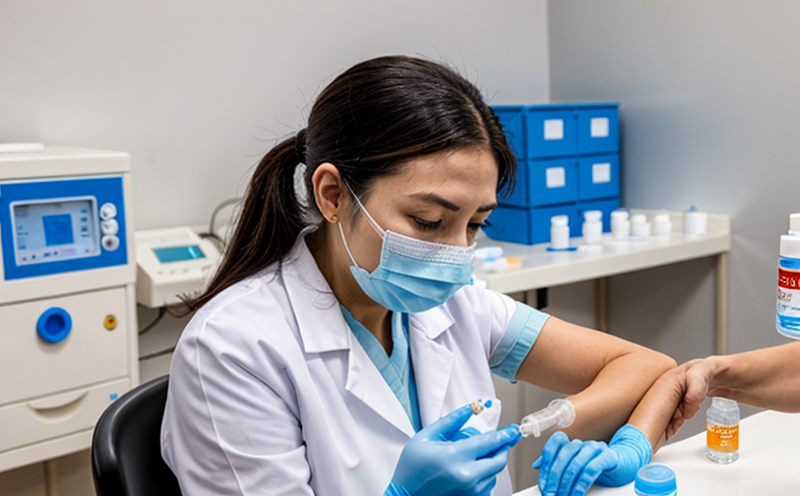WHO Lot Release Testing of Vaccines
The World Health Organization (WHO) lot release testing is a critical component in ensuring the safety, quality, and efficacy of vaccines before they are released for public use. This rigorous process aligns with international standards such as WHO guidelines and ensures that each batch meets stringent criteria set forth to protect public health.
Lot release testing involves a series of analytical procedures aimed at verifying several key aspects:
- Identity, purity, strength, and quality
- Absence or low levels of contaminants such as endotoxins, mycoplasmas, and adventitious agents
- Pharmacokinetic properties including stability under various conditions
The testing is not only important for the vaccine manufacturer but also for regulatory authorities who oversee the approval process. It ensures that each batch of vaccine meets the highest standards before it reaches clinical use or public distribution.
The detailed protocol involves multiple steps, starting with the receipt and sampling of the vaccine lots. Samples are then prepared according to standard operating procedures (SOPs) which include dilution, extraction, and other necessary manipulations depending on the nature of the vaccine. The testing process includes various analytical methods such as:
- Microbiological testing
- Virology tests for viral presence and identity
- Toxicology assessments to ensure safety
- Pharmacokinetic studies including stability under different conditions
The results of these tests are meticulously documented and reviewed by quality assurance teams. Compliance with WHO guidelines is paramount, ensuring that the vaccine batch meets all specified criteria.
Failure in any aspect of this testing can lead to significant delays or even rejection of the lot. Therefore, it is essential for pharmaceutical companies to ensure they have robust processes in place to meet these stringent requirements. This service ensures not only compliance but also builds trust with regulatory bodies and the public.
Why Choose This Test
The decision to conduct WHO lot release testing is crucial for several reasons:
- Regulatory Compliance: Ensures that all batches of vaccines meet international standards set by the WHO and other regulatory bodies.
- Quality Assurance: Provides a robust framework for quality control, ensuring consistent product performance across different batches.
- Patient Safety: Minimizes risks associated with adverse reactions by ensuring that only safe and effective vaccines reach the market.
- Enhanced Reputation: Builds trust with regulatory authorities and the public by demonstrating a commitment to high standards of manufacturing.
The detailed nature of this testing ensures that each vaccine batch is thoroughly evaluated, providing peace of mind for all stakeholders involved in the healthcare ecosystem.
Quality and Reliability Assurance
Quality assurance (QA) plays a pivotal role in the WHO lot release testing process. It encompasses several key components:
- Standard Operating Procedures (SOPs): Ensuring that all tests are conducted consistently according to predefined protocols.
- Data Validation: Rigorous checks to ensure data integrity and accuracy throughout the entire testing process.
- Training and Competence: Ensuring that all personnel involved in the testing are adequately trained and competent in their roles.
The use of advanced instrumentation and technology further enhances reliability, providing accurate and reproducible results. This approach not only meets regulatory requirements but also sets a benchmark for excellence within the industry.
In addition to these processes, regular audits and peer reviews are conducted to ensure ongoing compliance and improvement in quality standards. The ultimate goal is to provide a reliable and consistent product that can be trusted by healthcare providers and patients alike.
Use Cases and Application Examples
| Use Case | Description |
|---|---|
| Vaccine Production | Ensuring that each batch of vaccine produced meets the required quality standards before being released for public use. |
| Regulatory Compliance | Maintaining compliance with international regulatory standards to ensure safe and effective vaccines reach the market. |
| Patient Safety | Minimizing risks associated with adverse reactions by ensuring that only safe and effective vaccines are distributed. |
| Enhanced Reputation | Building trust with regulatory authorities and the public through consistent adherence to high standards of manufacturing. |
| Supply Chain Management | Ensuring smooth supply chain operations by providing reliable data on vaccine batches that meet all necessary criteria. |
| R&D Validation | Validating new formulations and processes through rigorous testing to ensure they meet established quality benchmarks. |
| Post-Market Surveillance | Monitoring the performance of vaccines post-release, using lot release data for ongoing improvement and safety monitoring. |
The above use cases illustrate how WHO lot release testing is integral to various stages of vaccine development and distribution. By ensuring compliance with international standards, this service supports a robust supply chain and enhances patient safety.





